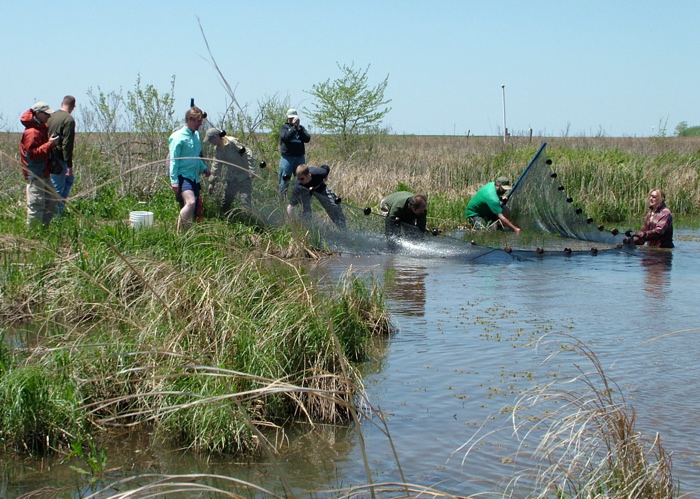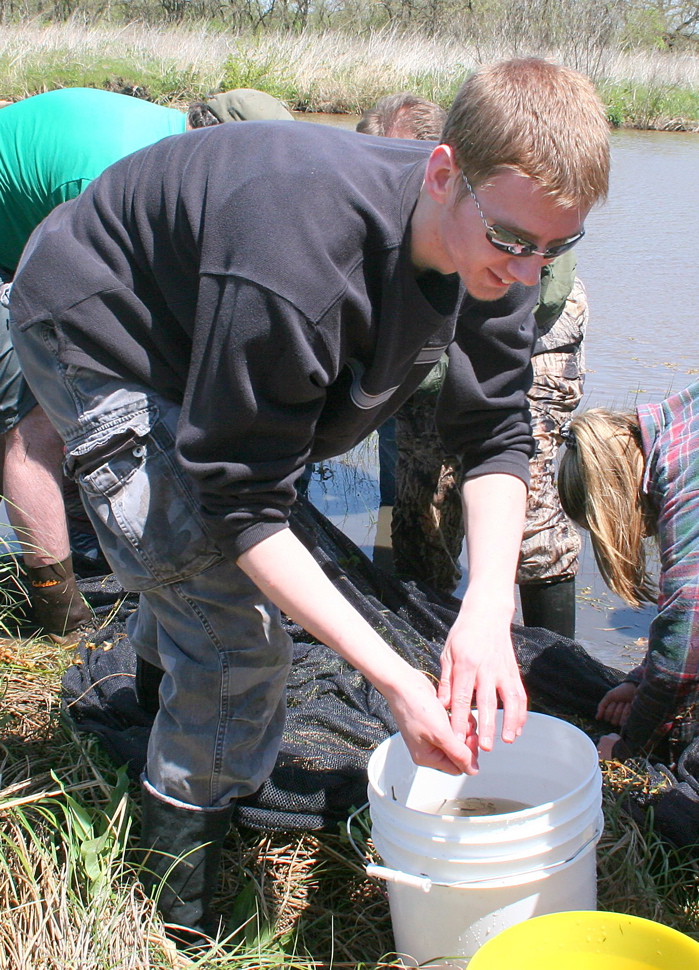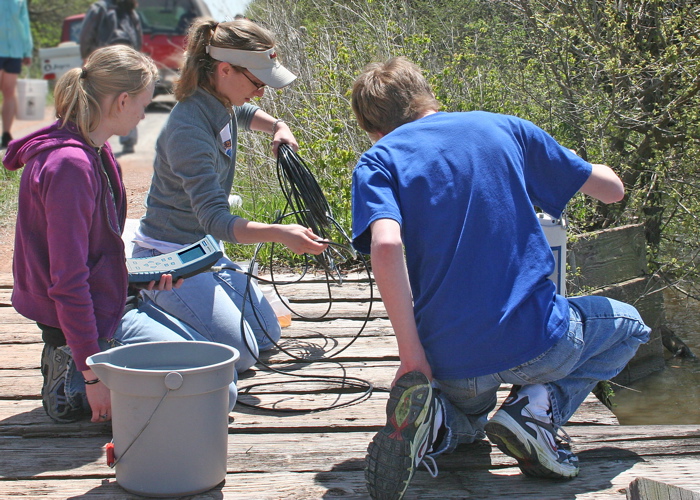Biological Sciences Field Station
|
|||||||||||||||||||||||||||||||||||||||||||||||||||||||||
| Fifty scientists, naturalists, volunteers, and high school students participated in Ninnescah Field Stations first annual BioBlitz on May 3, 2008. Within the 330 acres of native prairie, restored prairie, riparian woodland, and wetland habitats, blitzers recorded local biodiversity. Participating high school students used sweep nets, 40-foot seines, pit-fall traps, environmental monitoring equipment, water quality equipment, buckets, forceps, and hand lenses to collect and |
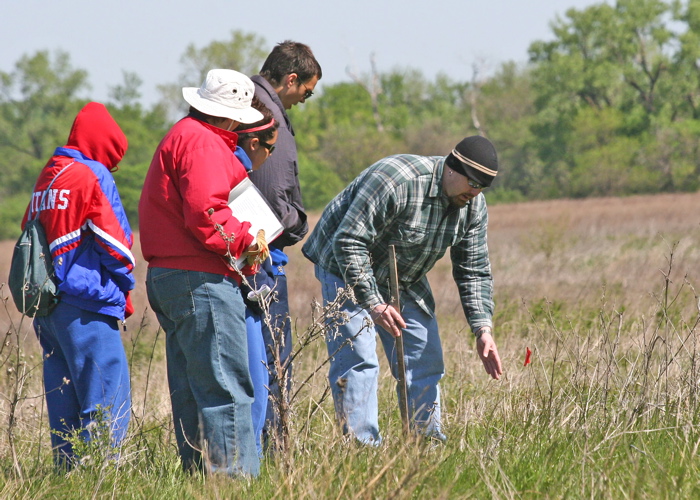
|
||||||||||||||||||||||||||||||||||||||||||||||||||||||||
|
observe the organisms found at Ninnescah. The BioBlitz took place from 9:00 am to 3:00 pm. Collectively, scientists and naturalists donated a total of 114 hours in which they identified plants, insects, fish, pond macro-invertebrates, snakes, and birds. Twenty four high school students from Wichita East High School, Wichita South High School, and Kapaun Mt. Carmel Catholic High School participated in the event and learned more about methods for investigating biodiversity. Seven teachers also participated in the event. Lowell Wilder (Kansas Film Producer) and Rosemary Wright (Freelance Photographer) generously donated their time to record the first annual Ninnescah Field Station BioBlitz. |
|||||||||||||||||||||||||||||||||||||||||||||||||||||||||
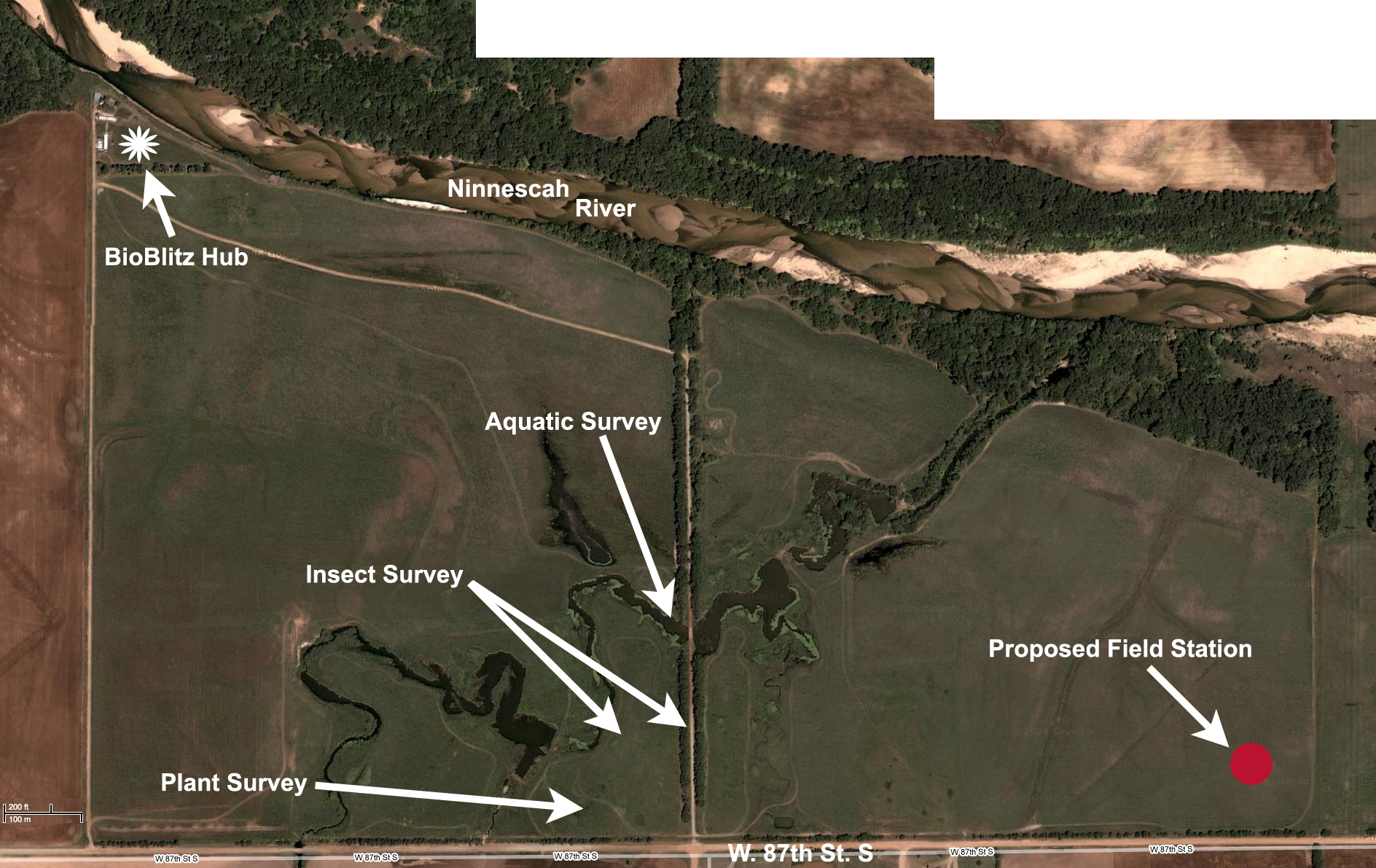
|
|||||||||||||||||||||||||||||||||||||||||||||||||||||||||
|
Among the new species that we recorded for Ninnescah Field Station were two species
of snakes that are now confirmed at Ninnescah: the Common Garter Snake (Thamnophis sirtalis) and the Western Rat Snake (Pantherophis obsoletus). Our list of Ninnescah reptiles now includes twelve species, and we are certain
that many additional species await discovery! Eleven species of fishes were added
to the Ninnescah species list: Warmouth (Lepomis gulosus), Orangespotted Sunfish (Lepomis humilis), Bullhead Minnow (Pimephales vigilax), Common Carp (Cyprinus carpio), Red Shiner (Cyprinella lutrensis), Western Mosquitofish (Gambusia affinis), White Crappie (Pomoxis annularis), Bluegill (Lepomis macrochirus), Gizzard Shad (Dorosoma cepedianum), Green Sunfish (Lepomis cyanellus), and Golden Shiner (Notemigonus crysoleucas). Sixteen species of fishes are now recorded at Ninnescah Field Station, and several
additional species await discovery. |
|||||||||||||||||||||||||||||||||||||||||||||||||||||||||
|
|||||||||||||||||||||||||||||||||||||||||||||||||||||||||
|
|||||||||||||||||||||||||||||||||||||||||||||||||||||||||
We thank the eighteen scientists and naturalists who participated in Bioblitz 2008 and who promoted active learning, citizen science, and enjoyment of local biodiversity: Roy Beckemeyer, Research Associate KU Natural History Museum Karen Brown, WSU Department of Biology Jim Culhane, WSU Department of Biology Don Distler, WSU Department of Biology Harry Gregory, Kapaun Mt. Carmel Catholic High School Mary Liz Jameson, WSU Department of Biology Lyle Jones, Wichita South High School Barry Raugust, Wichita East High School Leland Russell, WSU Department of Biology Maria Martino, WSU Department of Biology Shubha Shrestha, WSU Department of Biology Machale Spencer, WSU Department of Biology Vaughn Weaver, City of Wichita Environmental Water Quality Specialist Christine Wernert, WSU Department of Biology Lowell Wilder, Kansas Film Producer Rosemary Wright, Freelance Photographer Art Youngman, WSU Department of Biology Steve Yuza, WSU Department of Biology and Neosho County Community College |
|||||||||||||||||||||||||||||||||||||||||||||||||||||||||
|
BioBlitz 2008 Survey Data
|
|||||||||||||||||||||||||||||||||||||||||||||||||||||||||
|
Water Quality Data:
East Side of Bridge (Digitial Equipment):
*Note that turbidity on east and west sides of the bridge differ greatly. |
|||||||||||||||||||||||||||||||||||||||||||||||||||||||||
Insect Survey Data
Goal: Comparison of the composition of the carrion-feeding beetle guild in the south half
of the hedgerow and adjacent virgin prairie to the west of the hedgerow.
Survey Team: Roy Beckemeyer and Mary Liz Jameson
Equipment: Pre-set and pre-baited transect lines with pit-fall traps, sweep nets, long forceps,
jars for insects, white pans, environmental monitoring equipment
Date: May 3, 2008 (10:00 am-Noon)
Virgin Prairie Habitat:
| Carrion-Baited Pitfall | Carrion Feeding Species of Beetles | Other Arthropods |
| 1 | Onthophagus hecate (5) | -- |
| 2 | Onthophagus hecate (7) | -- |
| 3 | Onthophagus hecate (1) | Spiders, ants |
| 4 | Onthophagus hecate (1) | -- |
| 5 | -- | Ants, flies |
| 6 | -- | Ants, carabid beetle (1) |
| Control (unbaited pitfall) | ||
| 1 | -- | Ants |
| 2 | -- | -- |
| 3 | -- | Carabid beetle (1) |
| 4 | -- | -- |
| 5 | -- | Ants |
| 6 | -- | -- |
Environmental Data for Prairie:
Air Temperature: 12.8C/ 55.5F
Relative Humidity: 27%
Solar Insolation: 959.1 W/m2
Wind Speed: 0.3-8.1 m/s
Soil Temperature: 11.7C
Hedgerow Habitat:
| Carrion-Baited Pitfall | Carrion Feeding Species of Beetles | Other Arthropods |
| 1 | -- | Ants, opilionid (daddy long-legs) |
| 2 | -- | Fly, ants |
| 3 | -- | Spiders, ants, crickets, thrips |
| 4 | -- | Carabid beetle (1) |
| 5 | Staphylinidae (undetermined larva) (1) | Ants |
| 6 | -- | -- |
| Control (unbaited pitfall) | ||
| 1 | -- | Spider |
| 2 | -- | -- |
| 3 | -- | Spider |
| 4 | Trox sp. (1) | Spiders, springtails (Entomobryidae) |
| 5 | Staphylinidae (undetermined larva) (1) | Thrips |
| 6 | Staphylinidae (undetermined larva) (1) | Carabid beetle (1) |
Environmental Data for Hedgerow:
Air Temperature: 13.4C / 56.1F
Relative Humidity: 33.5%
Solar Insolation: 929.8 W/m2
Average Wind Speed: 2.7 m/s
Soil Temperature: 14.2C


